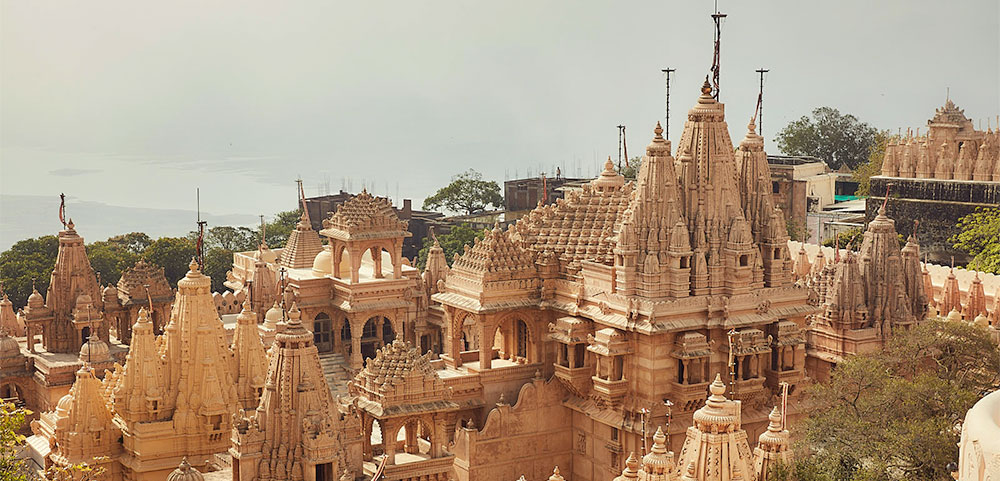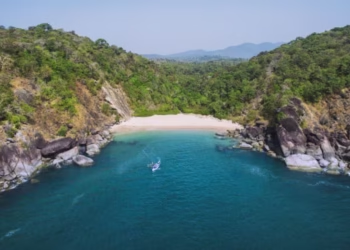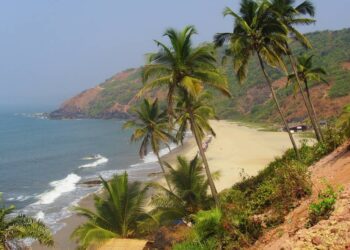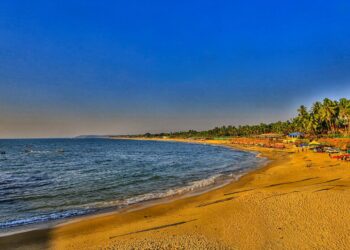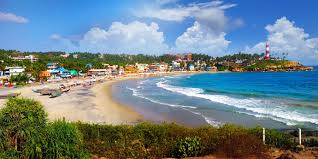Set high on Shatrunjaya Hill in Bhavnagar, Gujarat, the Palitana Jain Temples are a sacred group of over 800 shrines for Jain Tirthankaras, mostly Lord Adinath, the first Tirthankara. Built over a span of many years, starting way back in the 11th century, by Jain Sanghs, these temples, with white marble and carved tops, call to folks climbing 3,800 steps for blessings. Also known as “Padliptapur of Kathiawad” in historic texts, the dense collection of almost 900 small shrines and large temples have led many to call Palitana the “city of temples“. It is one of the most sacred sites of the Śvetāmbara tradition within Jainism.
Fun Fact: The main temple’s Adinath statue is said to shift colors with the sun’s rays.
Mythological Importance
Palitana Jain Temples hold old Jain stories. One tale says Lord Adinath, born long ago, found truth on this hill and turned into a Tirthankara, showing the way to freedom. Another story tells of a king praying here for a son, and his wish came true after he promised a shrine. According to the Shatrunjaya Mahatmya by Dhanesvara, a Jaina text in Sanskrit traceable to about the 14th century CE, Mahavira recited the legends of Rushabha to a solemn assembly on Shatrunjaya when deity Indra requested him to do so.
After nearly 300 verses, the text begins the description of Bharatam Varsham, followed by the glory of Shatrunjaya. The text declares it so holy, that even thinking about it “expiates many sins”. It then gives 108 alternate names for this site in verses 331 to 335, such as Pundarika giri, Siddikshetram, Mahabala, Surasaila, Vimaladri, Punyarasi, Subhadra, Muktigeham, Mahatirtham, Patalamula, Kailasa, and others. Of these names, the 11th-century Jaina scholar Hemachandra mentions two: Satrunjaya and Vimaladri.
In the Jain belief, the first Tirthankara Rishabha sanctified the hill where he delivered his first sermon. It was his first disciple Pundarika, who attained Nirvana at Shatrunjay, hence the hill was originally known as “Pundarikgiri”. There exists a marble image of Pundaraksvami consecrated in samvat year 1064 (1120 CE) by Shersthi Ammeyaka to commemorate the sallekhana of a muni belonging to the Vidhyadhara Kula.
Historical Overview
The temples started round the 11th century with Chaulukya kings, but some say worship was here before. Palitana was a Jain center, with traders giving money for shrines. A stone from 1194 shows early work. Raiders broke it in the 14th century, but Jain Sanghs built it back. By the 1600s, more shrines went up. In the 1800s, British folks wrote it was grand. After 1947, the Anandji Kalyanji Trust took over. Fixes in the 1980s kept the old look. Jain monks way back told its tale in talks. Now, many climb Shatrunjaya’s holy slopes. The temples’ past is full. Old Jain books from the 1200s talk of their beauty. British notes from the 1800s say it’s fine work. Ruins near Palitana show a Jain town from long ago.
Architecture of Palitana Jain Temples
Palitana Jain Temples cover Shatrunjaya Hill, built in Jain style. The main Adinath Temple, from the 12th century, has a high top with carvings of Adinath sitting, lotus flowers, and Jain marks, all in white marble. Inside, there’s a 3-foot marble statue of Adinath, legs crossed, deep in thought, lit by soft lamps. The inner walls have marble slabs with Jain prayers. The temples have halls with pillars carved with elephants and gods. Small shrines for Parshvanath, Mahavir, and Shantinath are on the hill, made of marble. The Parshvanath one shows him with a snake hood, for safety. The Mahavir one, from 1500, has him teaching, for truth. The Shantinath one shows him sitting, for quiet. The grounds, with stone paths, feel holy, high on the hill. A water tank for rituals has plain steps. Pillars tell Tirthankara stories, showing the way. The hill’s view brings peace.
Rituals and Festivals
The temples come alive when festivals hit. Paryushan, in August or September, is the big one, with fasting and praying for eight days. Mahavir Jayanti, in April, marks Mahavir’s birth with a climb. Diwali, in October or November, honors Mahavir’s final peace with lamps. Kartik Purnima, in November, brings thousands to climb. Samvatsari, in Paryushan, is for saying sorry.
Information for Travelers
Hours and Entry: Open every day, 6:00 AM to 8:00 PM. It’s free to go in, but prayers cost ₹100-300. No pictures in inner rooms.
Clothing: Wear clothes that cover shoulders and knees. Women for prayers wear sarees or suits, men wear kurtas.
How to Get There:
Air: Bhavnagar Airport, 60 km off, is closest. Taxis take 1.5 hours, cost ₹1200-1800.
Train: Palitana Station, 2 km away, links to Ahmedabad (5 hours). Autos cost ₹50-100.
Road: Buses from Bhavnagar (1 hour) come to Palitana. Taxis cost ₹800-1200. Roads are quiet.
Places to Stay: Palitana has guesthouses like Hotel Shravak (₹800-1500). Bhavnagar has hotels like Nilambag Palace (₹2000-3000). Stalls sell khaman, fafda, and tea.
Best Time to Visit: October to March is cool, 20-30°C. Weekdays are calm. Kartik Purnima’s packed, so plan early.
Nearby Attractions:
Shatrunjaya Hill Viewpoint, 1 km away, shows the temples.
Talaja Caves, 30 km away, are Buddhist caves.
Velavadar Blackbuck Sanctuary, 65 km away, has animals.
Gopnath Beach, 75 km away, is a sea spot.
Takhteshwar Temple, 50 km away, is a Shiva shrine.
Final Thoughts
Palitana Jain Temples in Bhavnagar, Gujarat, a holy spot in western India, is a treasure for the heart. The Tirthankaras’ pure touch reaches all who climb, making it a place you must see among India’s sacred spots.
